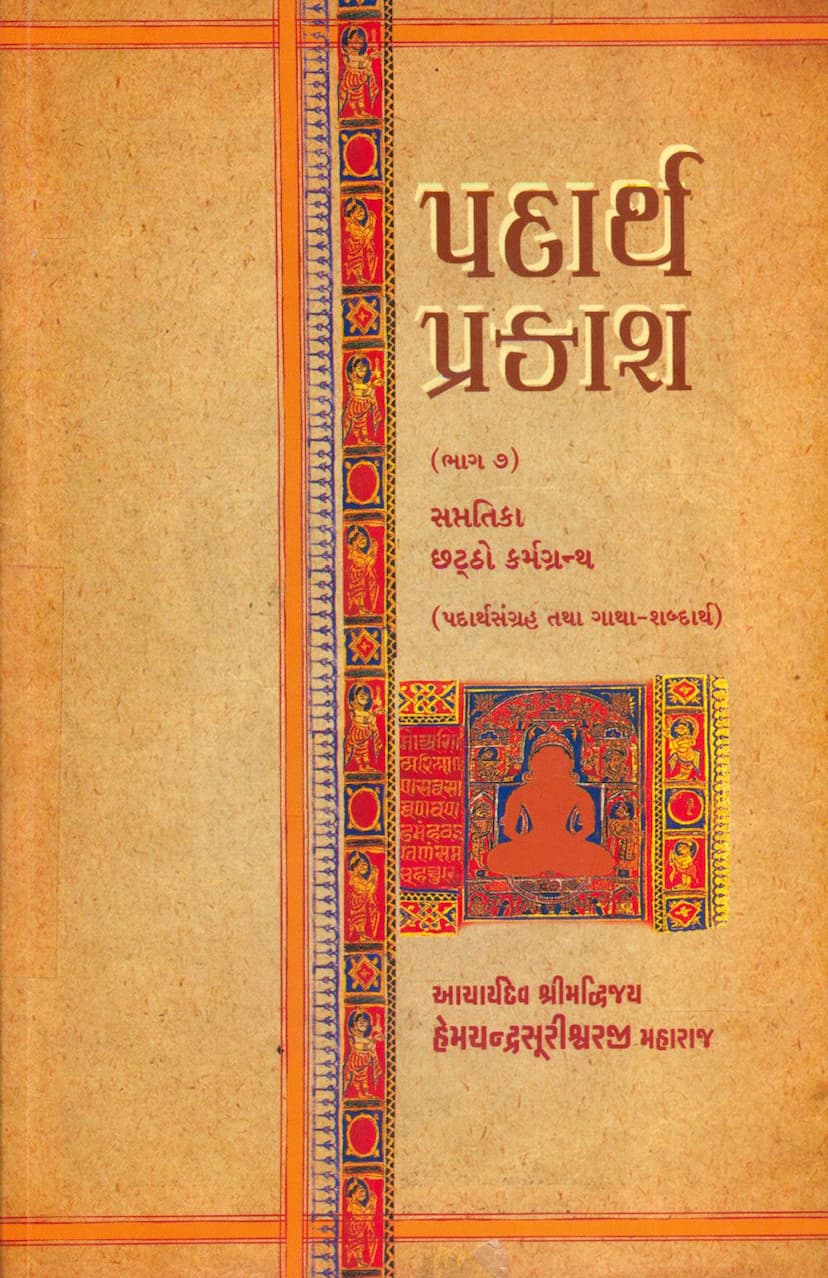Padarth Prakash 22 Saptatika
Added to library: September 2, 2025

Summary
The document provided is "Padarth Prakash, Part 7: Sixth Karmagranth (Collection of Terms and Glossary of Verses)" authored by Acharya Shri Vijay Hemchandrasuri. It is published by Sanghvi Ambalal Ratanchand Jain Dharmik Trust. This work is a continuation of a series aimed at making the complex concepts of Jain karma literature easily understandable.
Here's a comprehensive summary based on the provided pages:
Core Purpose and Context:
- Elucidation of Karma: The primary goal of this series, and specifically this seventh part, is to simplify and explain the intricate details of Jain karma theory, particularly focusing on the "Karmagranth" (scriptures on karma).
- Pedagogical Approach: The text aims to make the subject matter, starting from "Jeev Vichar" (philosophy of the soul) and progressing through four chapters, three parts, and six karmagranths, accessible to students and scholars alike.
- Lineage and Inspiration: The work is dedicated to the memory and teachings of the author's spiritual lineage, particularly Acharya Shri Vijay Premsurishwarji Maharaj and Acharya Shri Vijay Bhuvan Bhanusurishwarji Maharaj, who deeply studied and taught karma literature. The author, Acharya Hemchandrasuri, himself received profound knowledge of karma theory from his guru.
Content of "Padarth Prakash, Part 7":
- Focus on the Sixth Karmagranth: This volume specifically deals with the terms and glossary of the Sixth Karmagranth. The original text is attributed to Maharshi Shriyadhrishi Mahattar, with a commentary by Shri Malayagiri Maharaj.
- Detailed Explanation of Karma Concepts: The book systematically explains various aspects of karma, including:
- Bandhasthanak (Place of Bondage): Where and how karmas are bound.
- Udayasthanak (Place of Manifestation): When and how karmas manifest their effects.
- Sattasthanak (Place of Co-existence/Latent State): How karmas remain in the soul's latent state.
- Samvedh (Interrelation/Analysis): The detailed interrelation between bondage, manifestation, and latent states of karma across different "Jeev Sthanaks" (states of existence) and "Gunasthanaks" (stages of spiritual development).
- Specific Karma Types Covered: The text meticulously breaks down the analysis for:
- Mool Prakriti (Root Karma types): Discussing their bondage, manifestation, and latent states.
- Uttar Prakriti (Subsequent Karma types): Providing detailed analysis for specific karma types like:
- Jnāvarana (Knowledge-obscuring karma)
- Darshanavarana (Perception-obscuring karma)
- Antaraya (Obstructing karma)
- Vedaniya (Feeling karma)
- Ayushya (Life-span karma)
- Gotra (Status karma)
- Mohaniya (Delusion karma)
- Namkarma (Name/Form karma)
- Detailed Breakdown of Namkarma: A significant portion of the text delves into the complexities of Namkarma, analyzing its various "Bandhasthanaks" (places of bondage), "Udayasthanaks" (places of manifestation), and "Sattasthanaks" (places of latent state). This includes:
- How different life forms (Akeendriya, Viklendriya, Panchendriya, Manushya, Devi, Narak, etc.) bind, manifest, and retain Namkarma.
- The intricate "Bhangas" (permutations/combinations) associated with these processes across various "Jeev Sthanaks" (states of existence), "Gunasthanaks" (stages of spiritual development), and "Marganas" (categories of classification like Gati, Indriya, Yoga, etc.).
- A highly detailed examination of the "Bhangas" for Namkarma related to different species and stages of existence, including intricate tables and lists of these permutations.
- Analysis of Mohaniya Karma: The text also provides extensive details on the "Bandhasthanaks," "Udayasthanaks," "Sattasthanaks," and "Samvedh" for Mohaniya Karma, elaborating on the "Chovisi" (24 permutations) and "Padavishi" (permutations of terms) related to its manifestations across various "Gunasthanaks."
- Explanation of Upasham and Kshapan (Pacification and Annihilation of Karma): The latter part of the text delves into the processes of "Upasham Shreni" (path of pacification) and "Kshapan Shreni" (path of annihilation), explaining how different karmas, especially Mohaniya karma (like Anantanubandhi, Darshan Mohaniya, and Charitra Mohaniya), are pacified or annihilated through specific "Karan" (actions/stages) in different "Gunasthanaks."
Key Methodologies and Concepts:
- Intricate Tabulation and Analysis: The book is characterized by its systematic presentation of data in tables, detailing the interplay of karmas across various classifications.
- Bandhasthanak, Udayasthanak, Sattasthanak, Samvedh: These are the fundamental analytical frameworks used throughout the text to understand the karma process.
- Jeev Sthanak and Gunasthanak: The analysis is consistently mapped onto the 14 "Jeev Sthanaks" and the 14 "Gunasthanaks" to illustrate how karma operates differently in each state.
- Marganas: The text also applies "Marganas" (classifications like Gati, Indriya, Kriya, Lesehya, Yoga, etc.) to further refine the understanding of karma.
- Understanding Nuances: The book highlights subtle distinctions and differing viewpoints ("Matantar") from various Acharyas, demonstrating the depth of the subject.
Overall Significance:
"Padarth Prakash, Part 7" is a scholarly work that aims to demystify the complex field of Jain karma philosophy. It provides a systematic and detailed breakdown of the Sixth Karmagranth, making its teachings accessible through clear explanations, comprehensive tables, and detailed analysis of permutations and interrelations of karmic states. The work is a testament to the author's dedication to spreading Jain philosophical knowledge.